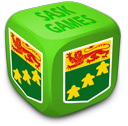Are you stealthy enough to steal the Emperor's jewel?
That is the question you try to answer in Age of Thieves, a game by designer Sławomir Stępień, and published by Galakta Games.
"Welcome to Hadria, Pride of the North, a hub of fervent activity for rich merchants, diligent burghers, resourceful inventors... and cunning thieves," details the rule book in creating the game's background. "It is a special time for its citizens - Emperor Lucius IV and a retinue of powerful lords and ladies have come to the Sea Palace to oversee their domains. A time of great festivities has begun and there is no ending to all the feasts and joy! However, shady personas controlling the city are not so much interested in Lucius IV himself as in the Emperors' Jewel, the crown jewel and the symbol of power for the ruling dynasty. Anyone who takes possession of this unique treasure will not only gain unthinkable riches, but will also become the most wanted fugitive of the Empire. That is the reason why only the most clever and the boldest of thieves are willing to dare such a burglary. Others will have to settle for shiny trinkets belonging to the Emperor's court."
The theme is good, thieves out to steal the big prize, with it being every rogue for themselves.
The goal of the game is to enter the vault inside the palace and steal the Emperors' Jewel, the symbol of power very important for the ruling house. Whoever manages to do this must escape from the city through one of the gates.
"This is no easy task - the streets are patrolled by vigilant guards and veteran captains who know almost everything about thieves' tricks. Additionally, time is running out very quickly - each turn a new event card is revealed increasing the pace of the game and constantly raising its difficulty," notes the rules.
But how does the game look, and play?
A general observation, everything in this game comes off as a tad undersized. The board is somewhat crowded, and a bit hard to decipher in places as a result. Bigger would have been better.
A bigger board would have allowed for slightly more robust minis.
And the cards are small, so the print is too.
None of the smallness is so extreme it is a game breaker, but the general impression is the game is a bit 'compressed'.
As for game play, it can have an anti-climactic finish, which on a first play, was somewhat underwhelming.
Our first game was going along quite well, when one player threw down a card combo and snatched the victory. For him it was a case of 'ta-da! Look at what I did!"
For the rest of us the win seemed so over the top our collective view of the game dropped in a hurry.
But I don't write a review at the table, so I went home and gave the rules a read again. There are times when what feels like a 'broken win' occurs in an early game we find we missed a rule that would have made the difference. Not so in this case.
But the time allowed me some reflection.
When games rely on card draw sometimes things just fall perfectly for a player.
A case in point, after our Thieves game we pulled out the original Dominion for a couple of games. The cards in the second game were on my side. While the bandit was pulling gold and silver from other players my deck was running lucky. Not only was I not losing treasure, it was actually making me pull better hands. I crushed the game. If that had been a first game experience it would have not been great for the rest of the table.
And recently my son and I grabbed a couple of new Magic: the Gathering constructed decks. We had not played a game in literally years. In two of the first four, or five games, I couldn't pull enough 'mana' cards to do much of anything. Since Magic relies on mana at the core of play I got thumped.
Bad draws and good are part of card game play.
That isn't to say the card draw aspect of Thieves works perfectly. In games such as this, not all cards are created equal, and when you can get the best cards and can play them in combination they tend to taint how players feel after a game, if the cards are not just more bluntly put; game-breaking.
Map of Sewers and Cog Rod are a frightful combo in Thieves. Whoever gets the Emperor's jewel is likely to escape via the sewers. Throw down the map and you are right where they end up, and the road completes the steal.
Speaking of the sewer escape, having that obvious route out of the palace does seem a tad forced in this one.
So Thieves is not perfect. Few games are.
There is however, a lot to like here, once we got past the bad first game finish.
There initially seems to be a lot going on with all the minis, chits, and cards, but a couple of rounds and you realize game play is quite smooth. You have decisions to make within a turn, but when you make them is well-defined with a set pattern of play to follow.
In the end it's easy to recommend this one. There is good replay and overall things work here. It won't make your top-10 list, but you will never shy away from putting it on the table for a session when you are up for a challenge against your friends and the game itself.
Check it out further at www.galakta-games.com
Thanks to fellow gamers Jeff Chasse, Trevor Lyons and Adam Daniels for their help in running through this game for review.
